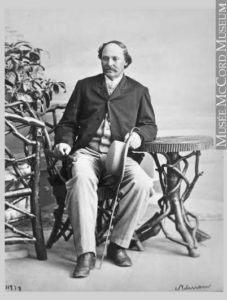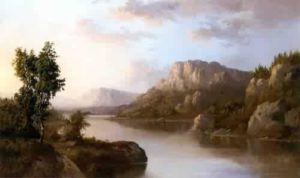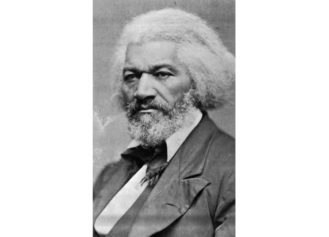By Chermelle Edwards
In a half century’s time, Robert Seldon Duncanson lived a life pioneering his role as an influential American painter, leading with art first and cultural background second. He famously wrote to his son, “I have no color on the brain; all I have on the brain is paint.”
Duncanson born in Seneca Country, New York, grew up in a dual citizenship family – Canadian and American—living at times with his Canadian father and at other times with his American mother in Mount Pleasant, Ohio. When he settled in the town of his mother at the age of twenty, he vowed to be more than a house painter and decorator, but an artist.
“I’ve come back to be an artist,” said the young visionary.
But he didn’t stay there for long, he had sights on the city just fifteen miles from him, Cincinnati, and became an autodidact artist, teaching himself how to paint. Portraits and prints were his focus as well as breaking the label of being label an African American painter.
Within a year of his move to Cincinnati, Duncanson was introduced to the world with three of his portraits at the Society for the Promotion of Useful Knowledge— “Fancy Portrait,” “Infant Savior” and “Miser” were the works that were shown. Despite his accomplishment, he was well aware of the barrier that color brought up when his mother couldn’t attend his debut because she was Black.
Intent on not being pigeonhole by the racial mores of the time, Duncanson focused on diversifying himself and his work. Three years later, in 1844, Duncanson joined with Coates, a photographer with a penchant for technicality to create “Chemical Paintings,” a composition of Daguerre images held in a Cincinnati auditorium; “Hagia Sophia,” ”Last Supper,” “Destruction of Nineveh” and Belshazzar’s Feast,” set to music and lighting effects. The collaboration was historic, but as an African American artist who had yet to see the rise of anti-slavery and abolitionist support, he moved a year later to a downtown studio in Detroit.
Never settling with one form, while in Detroit, Duncanson’s “Drunkards Plight,” became an example of his experiment with genre subjects, which other American painters of the late 1840’s also fancied – they captured the everyday activities of Americans in the social and political arenas. Soon, Duncan opened a studio, mentoring other young Black artists like Frederick E. Cohen. But, ever on the move, he returned to Cincinnati in the summer of 1846 to his first self-taught love, painting portraits while also focusing on genre subjects.
With no formal training, Duncanson’s work consistently caught the eyes of his white counterparts—the press, art contemporaries, and even abolitionists. A journal, The Liberator, reported that his paintings begin picking up interest from abolitionist journals and patrons. While it did, per Duncanson’s creative pattern, he began experimenting with something new —travel prints —and painted two canvases toward the end of the 1840s. This, like genre painting, became a favorite of other painters as well as drawing destinations like Central America, the American West, the Middle East and Africa.
At this time, Duncanson’s largest commission, a landscape
painting of Cliff Mine, Lake Superior, was ordered by Reverend Charles Avery, a minister and investor to commemorate the first lucrative ship of copper to dock in America. Duncanson captured the nature of Cliff Mine, Lake Superior with romanticism while highlighting the issue of destruction, which forever changed the life of the painter, forging a career in landscape painting supported by patrons until his death. Now, emerged as a landscape painter of his generation and a primary Ohio River valley painter; he toured lakes, made sketching trips, imbued paintings with symbolic meanings, painted firsts in American history and eventually developed a decade long partnership with colleague William Sonntag which influenced his style.
During the two years 1850-1852, Duncanson’s Ohio River Valley sketching tours resulted in the subsequent creation of eleven landscape paintings for the Western Art Union exhibition, formally declaring him as a landscape painter to critical praise. Choosing to settle in Cincinnati as a freed man in an increasing antebellum American society, he was welcomed by the city which now offered him a myriad of ways to pursue his art, not far from where he grew up as a young boy and where once, his mother wasn’t allowed to see his exhibited work because of the color of her skin.
Never forgetting his upbringing or the plight of Blacks in America, his painting “View of Cincinnati, Ohio from Covington, Kentucky” is considered to be his thoughts on slavery expressed in art form. Taking liberties with his painting style, he digressed from the reference photo he used, inserting Black characters where white ones were, showing the contemporary relationship between free whites with enslaved people. Then, Duncanson’s penchant for didactic exploration, turned historical for the next three years with his painting “The Garden of Eden,” one of his most romantic, artistic works to date, a “chef d’oeuvre”—a symbolic parallel to Paradise Lost by John Milton.
As he continued his sketching tours, his works took on moral themes and literary tropes becoming the first among an art show in Detroit, Michigan where he would become known as a major contributor to the city’s visual arts. While his career was going well, things would change significantly for the painter upon his discovery by one of the wealthiest men in the United States, Nicholas Longworth, arts patron, antislavery supporter, landholder and horticulturalist in Cincinnati.
Longsworth commissioned him to design his home with landscape murals, eight in all—nine feet high, six and a half feet wide—the largest of Duncanson’s career and most accomplished before the Civil War. Longsworth would become a patron to Duncanson, more than any other artist, eventually entrusting the painter to do a sequence of decorative murals of pictoral progression and classical pastoral landscapes for Belmont, an estate belonging to Longsworth. These paintings would become covered with wallpaper during the artists’ lifetime, after the estate was sold following Longsworth’s death.
Rediscovered in 1931, upon removal of the wallpaper, which covered it, the eight original murals now remain in the Taft Museum of Art. Upon completing a work in one style, Duncanson again switched creative genres and spent four years from 1854-1858 working with photographer James Presley Ball in his studio, retouching portraits and coloring photographic prints, only to produce in its end a 600 yard abolitionist painting “Mammoth Pictorial Tour of the United States Comprising Views of the African Slave Trade.”
Never one to be confined to one artistic genre, when the civil war finally arrived, Duncanson imposed a self-exile and fled to Canada and the U.K., staying two years in Montreal. Influenced by his new home, he created “The Land of the Lotus Eaters,” then left Canada to tour it in the U.K which itself became creative fodder for his later pastoral paintings of calm and serenity.
Duncanson would spend the last twenty years of his life creating works across multiple genres while traveling the world; Canada, Italy; Scotland, England and the U.S. until his death in 1872, etching himself into world history as one of the most prolific pre-Civil war landscape painters of his time with nearly two dozen of his works appearing in more than a dozen museums today.




